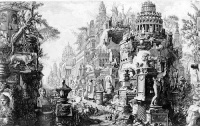Antichita Romanae
From The Art and Popular Culture Encyclopedia
| Revision as of 10:57, 17 July 2009 Jahsonic (Talk | contribs) ← Previous diff |
Current revision Jahsonic (Talk | contribs) |
||
| Line 1: | Line 1: | ||
| - | [[Image:Antichità Romane.jpg|thumb|right|200px|The late [[Baroque]] works of [[Claude Lorrain]] and [[Salvatore Rosa]] had featured [[romantic]] and [[fantastic]] depictions of [[ruin]]s; in part as a [[memento mori]] or as a [[reminiscence]] of a [[golden age]] of [[architecture]]. [[Piranesi]]'s reproductions (see right) of real and [[fictitious]] [[Roman Empire|Roman]] ruins were a strong influence on [[Neoclassicism]]. ]] | + | {| class="toccolours" style="float: left; margin-left: 1em; margin-right: 2em; font-size: 85%; background:#c6dbf7; color:black; width:30em; max-width: 40%;" cellspacing="5" |
| + | | style="text-align: left;" | | ||
| + | "Many years ago, when I was looking over [[Piranesi]]'s ''[[Antiquities of Rome]]'', Mr. [[Coleridge]], who was standing by, described to me a set of plates by that artist, called his ''Dreams'', and which record the scenery of his own visions during the delirium of a fever. Some of them (I describe only from memory of Mr. Coleridge's account) represented vast gothic halls; on the floor of which stood all sorts of engines and machinery, wheels, cables, pulleys, levers, catapults, &c, expressive of enormous power put forth, and resistance overcome. Creeping along the sides of the walls, you perceived a staircase; and upon it, groping his way upwards, was Piranesi himself: follow the stairs a little further, and you perceive it come to a sudden, abrupt termination, without any balustrade, and allowing no step onwards to him who had reached the extremity, except into the depths below. Whatever is to become of poor Piranesi, you suppose, at least, that his labors must in some way terminate here. But raise your eyes, and behold a second flight of stairs still higher; on which again Piranesi is perceived, by this time standing on the very brink of the abyss. Again elevate your eye, and a still more aerial flight of stairs is beheld; and again is poor Piranesi busy on his aspiring labors; and so on, until the unfinished stairs and Piranesi both are lost in the upper gloom of the hall."--''[[Confessions of an English Opium-Eater]]'' (1821) by Thomas De Quincey | ||
| + | |} | ||
| + | [[Image:Antichità Romane.jpg|thumb|right|200px|The [[Appian Way]] as it appeared in Piranesi's imagination (1756), from ''[[Antichita Romanae]]'']] | ||
| {{Template}} | {{Template}} | ||
| - | ''[[Antichita Romanae]]'' ([[1748]]) is a series of prints by [[Giovanni Battista Piranesi|Piranesi]] of real and [[fictitious]] [[Roman Empire|Roman]] ruins, inspired by the late [[Baroque]] works of [[Claude Lorrain]] and [[Salvatore Rosa]] who had featured [[romantic]] and [[fantastic]] depictions of [[ruin]]s; in part as a [[memento mori]] or as a [[reminiscence]] of a [[golden age]] of [[architecture]]. [[Piranesi]]'s reproductions (see right) were a strong influence on [[Neoclassicism]]. | + | ''[[Antichita Romanae]]''[http://commons.wikimedia.org/wiki/Category:Le_antichit%C3%A0_Romane_%28Piranesi%29] ([[1748]]) is a series of prints by Italian artist [[Giovanni Battista Piranesi|Piranesi]] of real and [[fictitious]] [[Roman ruins]], inspired by the late [[Baroque]] works of [[Claude Lorrain]] and [[Salvatore Rosa]] who had featured [[romantic]] and [[fantastic]] depictions of [[ruin]]s; in part as a [[memento mori]] or as a [[reminiscence]] of a [[golden age]] of [[architecture]]. [[Piranesi]]'s reproductions (see right) were a strong influence on [[Neoclassicism]]. |
| + | ==Full title== | ||
| + | Title page: Roman Antiquity of the Time of the Republic and the First Emperors (Antichità Romane de' Tempi della Repubblica, e de' primi Imperatori).[http://metmuseum.org/Collections/search-the-collections/365377?rpp=20&pg=5&rndkey=20140304&ao=on&ft=*&when=A.D.+1600-1800&who=Giovanni+Battista+Piranesi&pos=96] | ||
| + | |||
| + | ==See also== | ||
| + | *[[Architectural illustration]] | ||
| + | *[[Classical archaeology]] | ||
| + | *[[Topography of ancient Rome]] | ||
| - | == External links == | ||
| - | *http://visualiseur.bnf.fr/CadresFenetre?O=IFN-2000054&M=notice | ||
| - | *http://bibliodyssey.blogspot.com/2006/05/imagining-classical-piranesi.html | ||
| {{GFDL}} | {{GFDL}} | ||
Current revision
|
"Many years ago, when I was looking over Piranesi's Antiquities of Rome, Mr. Coleridge, who was standing by, described to me a set of plates by that artist, called his Dreams, and which record the scenery of his own visions during the delirium of a fever. Some of them (I describe only from memory of Mr. Coleridge's account) represented vast gothic halls; on the floor of which stood all sorts of engines and machinery, wheels, cables, pulleys, levers, catapults, &c, expressive of enormous power put forth, and resistance overcome. Creeping along the sides of the walls, you perceived a staircase; and upon it, groping his way upwards, was Piranesi himself: follow the stairs a little further, and you perceive it come to a sudden, abrupt termination, without any balustrade, and allowing no step onwards to him who had reached the extremity, except into the depths below. Whatever is to become of poor Piranesi, you suppose, at least, that his labors must in some way terminate here. But raise your eyes, and behold a second flight of stairs still higher; on which again Piranesi is perceived, by this time standing on the very brink of the abyss. Again elevate your eye, and a still more aerial flight of stairs is beheld; and again is poor Piranesi busy on his aspiring labors; and so on, until the unfinished stairs and Piranesi both are lost in the upper gloom of the hall."--Confessions of an English Opium-Eater (1821) by Thomas De Quincey |

|
Related e |
|
Featured: |
Antichita Romanae[1] (1748) is a series of prints by Italian artist Piranesi of real and fictitious Roman ruins, inspired by the late Baroque works of Claude Lorrain and Salvatore Rosa who had featured romantic and fantastic depictions of ruins; in part as a memento mori or as a reminiscence of a golden age of architecture. Piranesi's reproductions (see right) were a strong influence on Neoclassicism.
Full title
Title page: Roman Antiquity of the Time of the Republic and the First Emperors (Antichità Romane de' Tempi della Repubblica, e de' primi Imperatori).[2]
See also

